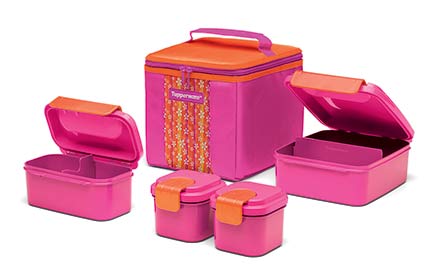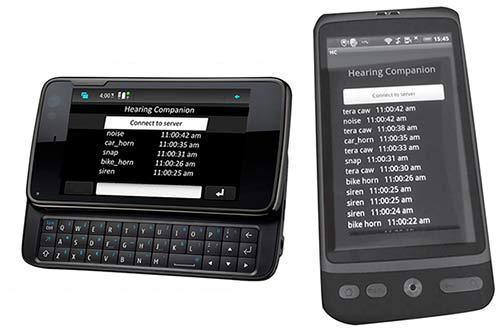The Center on Knowledge Translation for Technology Transfer: Success Stories and Resources for R&D Practitioners

TECHNICAL BRIEF NO. 38 - 2013
A Publication of SEDL's Disability Research to Practice Program
The Center on Knowledge Translation for Technology Transfer: Success Stories and Resources for R&D Practitioners
Jennifer L. Flagg, MBA, Center on KT4TT, University at Buffalo (SUNY)
This FOCUS Technical Brief invites you to explore the materials and insights the Center on Knowledge Translation for Technology Transfer (KT4TT) has compiled from 2008–2013. We hope they help you to avoid the most common barriers and overcome the most perilous struggles along the Research and Development (R&D) path to successfully commercialize your sponsored project outputs. To that end, we describe the outputs from our own R&D projects.
At the beginning, five years seemed ample time to explore and describe best practices in knowledge translation (KT) and technology transfer (TT). The Center on Knowledge Translation for Technology Transfer (KT4TT) was awarded to the University at Buffalo (SUNY), Center for Assistive Technology (CAT) on October 1, 2008, by the National Institute on Disability, Independent Living, and Rehabilitation Research (NIDILRR). Now in 2013, at the end of this funding cycle, we realize that much remains to be understood and explained in the realm of KT for TT. However, thanks to careful planning and budgeting of time and resources, we were able to meet and even surpass our initial goals to generate new conceptual frameworks, develop prototype inventions, and facilitate the transfer of innovative products to the marketplace.
Each project's purpose and the resulting outputs are described, along with web links where you can access more information. For a recap on our progress through the years, take a look at our previous newsletters at https://sphhp.buffalo.edu/cat/kt4tt/dissemination/publications-and-presentations/newsletters.html.
Explore the Need to Knowledge (NtK) Model to understand the key success factors involved in new product development.
This research project analyzed published findings to improve understanding of how to successfully communicate and transfer the results of R&D studies that have potential value to society. The study considered models, methods, metrics, barriers and carriers, as well as best practices from the fields of new product development and technology transfer. A thorough review of academic and industry literature, which is detailed in an Implementation Science article,Footnote 1 led to the creation of the Need to Knowledge Model. The NtK Model is described in FOCUS Technical Brief #28Footnote 2 as a new product development and technology transfer model geared towards university-based researchers who are generating technology-based devices and services intended for use in the marketplace. It offers parity to the rigor of development and production activities that are overlooked by many applied researchers, as discussed in an article in Technology and Disability.Footnote 3 The theoretical underpinnings of this viewpoint are explored in an article that views knowledge as residing in three distinctly different states; discovery, invention and innovation.Footnote 4
Figure 1: Need to Knowledge Model Game Board
Figure 1 Text Description [Select image to enlarge]
http://kt4tt.buffalo.edu/knowledgebase/gameboard.php
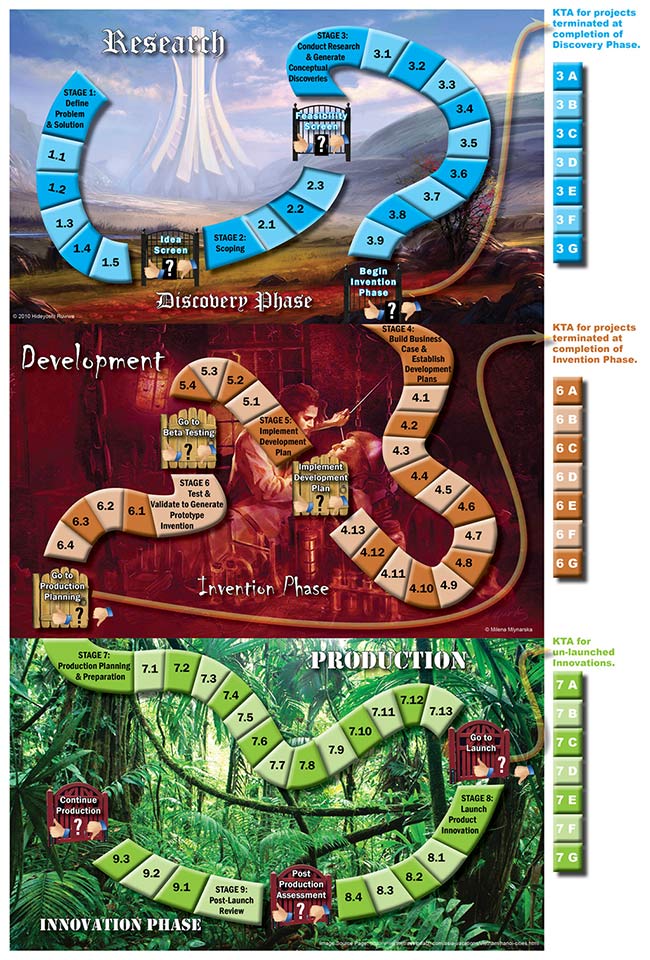
Copyright © 2021 Center on KT4TT. Used by SEDL with permission.
The NtK Model is freely available on our website and can be viewed in two formats. First, a table versionFootnote 5 allows users to explore the supporting evidence related to each stage and step by clicking on magnifying glass icons  . Toolbox icons
. Toolbox icons  bring users to listings of tools for conducting technical, business or market analyses, which may be called for in specific steps of the framework. Case studies drawn from our internal team's own prior commercialization experience highlight each stage by providing an example for completing a critical activity. A second version of the model appears as a game board where users can click on a path to uncover stage and step names (see Figure 1). We plan to expand the game board's capabilities to offer “what if” scenarios as illustrations of what works, what doesn't and why.
bring users to listings of tools for conducting technical, business or market analyses, which may be called for in specific steps of the framework. Case studies drawn from our internal team's own prior commercialization experience highlight each stage by providing an example for completing a critical activity. A second version of the model appears as a game board where users can click on a path to uncover stage and step names (see Figure 1). We plan to expand the game board's capabilities to offer “what if” scenarios as illustrations of what works, what doesn't and why.
Grantees interested in generating technological solutions to societal problems have found the NtK Model to be useful for writing grant proposals, generating technology transfer and commercialization plans, and better understanding the rigor involved with development and production activities.
Another related Implementation Science articleFootnote 6 considers the NtK Model using a logic model framework to help users better understand and apply the model to their own work. Finally, a technology transfer planning templateFootnote 7 is available for investigators to plan their projects using the NtK Model's stages and steps.
Assess the extent to which national organizations can help you to share R&D outputs with large communities of stakeholders.
Investigators and their sponsors are increasingly tasked with sharing their project outputs with a broader range of potential users (stakeholders) in an effort to increase the outcomes and impacts stemming from their work. One way to maximize reach beyond traditional academic audiences, while minimizing the time and effort required to do so, is to communicate a message to relevant national organizations that in turn are positioned to channel your message to their members. To better understand how organizations value, create and/or used new knowledge from R&D projects, we applied a technique called knowledge value mapping. Knowledge value mapping draws upon attitudes explored through surveys and interviews to understand the values and interests of the target organizations so that delivery mechanisms and message content can be tailored to resonate with the organizations and their members. In our example we interviewed national organizations representing six distinct stakeholder groups (consumers, brokers, policy makers, researchers, clinicians, and manufacturers) to determine their level of interest in such new knowledge. It turns out they have high interest and are willing to work closely with investigators to ensure their findings are widely shared. This cost-effective technique for enhancing targeted dissemination activities is described in another Implementation Science journal article,Footnote 8 as well as FOCUS Technical Brief #32.Footnote 9
Use knowledge translation interventions to increase interest in your own project's findings and deliverables.
We conducted a series of three randomized controlled studies to compare the results of applying three different communication strategies for sharing new findings from R&D projects with members of five audience types (stakeholder groups). The three strategies are:
- Knowledge Translation: creating material tailored to the values and context of the target audience (tailored contextualized knowledge packages)Footnote 10 and delivering the information through multiple media (hardcopy packages and access to webcasts)Footnote 11
- Traditional Dissemination: delivering hardcopies of previously published articles to participants.
- Passive Diffusion: where we delivered nothing, but assessed the extent to which people were aware of the previously published articles both at the beginning and end of the studies.
We applied a new survey instrument to measure people's awareness of, interest in, and decision to apply the new findings. Results were mixed among the three studies, but overall showed that the extra effort required to tailor and target materials will indeed increase awareness of, and interest in findings across various audiences. However, it appears that no amount of external persuasion will make a person use knowledge. Instead, that decision rests chiefly with the individual. Descriptions of the methods and results of this project are available in a webcastFootnote 12 and in two conference presentations: one reporting the results of the initial study,Footnote 13 and another reporting on the first replication.Footnote 14 A companion manuscript for journal publication is in draft form. If you wish to be notified when it is released, please send an email to: vstone@buffalo.edu.
Check out five new Assistive Technology (AT) products now available in the marketplace.
We had proposed to accomplish product outcomes from R&D while demonstrating KT for TT practices to NIDILRR technology grantees so the grantees could have direct experience as ‘participant-observers' in the full range of activities and constraints involved in the conception, design and delivery of new AT products to the marketplace. As a condition of funding we were to work in only three AT areas, and we chose: Augmentative and Alternative Communication (AAC); Mobility; and Environmental Access. Many of the lessons learned from these five successful development projects—particularly regarding consumer involvement in new product development—were captured and reported in a recent Research Technology Management article.Footnote 15
Emergency Communications for All (EC4All) App
https://www.createabilityinc.com/
This smartphone app for Android™ was developed in collaboration with CreateAbility Concepts, Inc.,Footnote 16 the Rehabilitation Engineering Research Center on Communication Enhancement (ACC-RERC)Footnote 17 and Temple University. The app replaces a lost AAC device in an emergency to allow people who cannot verbally communicate to quickly and easily communicate with others, such as emergency personnel and first responders, who have this app on their smartphones. Users can type words or select icons using the emergency personnel's phone touch screen, and the app verbally communicates the user's message. The app covers a comprehensive list of preprogrammed words, and all icons are no more than three pages away.
Figure 2. Emergency Communications for All Smartphone App for Android
Figure 2 Text Description [Select image to enlarge]
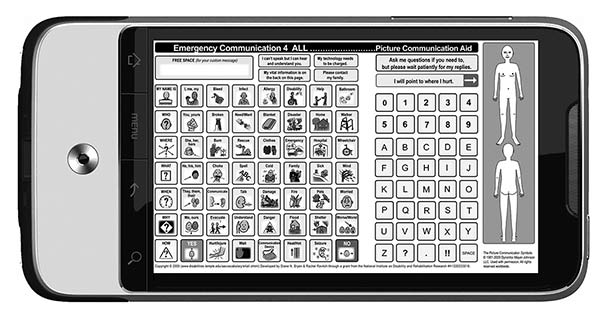
From Emergency Communication 4 All, by D. N. Bryen and R. Ravitch through a grant from the National Institute on Disability, Independent Living, and Rehabilitation Research #H133E033018. Copyright © 2009 by the Institute on Disabilities at Temple University. The Picture Communication Symbols © 1981-2009, DynaVox Mayer-Johnson LLC. All rights reserved worldwide. Android is a trademark of Google Inc. SEDL used with permission from the Institute and in compliance with Android and Dynavox Mayer-Johnson's terms of use.
First Crush™ Electric Pill Crusher
This product is the first ever automated pill crusher, and was conceived and designed by the RERC on Technology TransferFootnote 18 and brought to market by First Wave Technologies.Footnote 19 Its patented 'dual action' crushes and grinds pills, turning them into a fine powder. Full automation provides better staff utilization and reduces repetitive motion injuries by eliminating the strength needed to crush pills manually. Complete RX Cups have a textured surface allowing for direct grinding action, and allow a caregiver to crush, mix and serve from the same container.
Figure 3: First Crush™ Electric Pill Crusher
Figure 3 Text Description [Select image to enlarge]
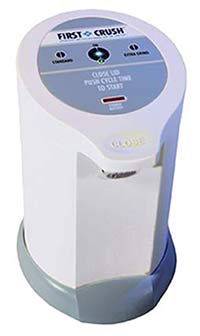
Copyright © 2010 First Wave Technologies, Inc.
All rights reserved. Reprinted by SEDL with permission.
MORPH™ Foldable Wheelchair Wheels
http://morphwheels.com
The world's first foldable wheelchair wheel is now available on the market for purchase as a result of collaboration with the Mobility RERC,Footnote 20 Maddak, Inc. Footnote 21 and Beneficial Designs, Inc.Footnote 22 Designed for travel in cars, trains, and airplanes, the wheels fold for easy storage, and will even fit in airplane overhead storage compartments. Weighing only 7.5 lbs. each, the wheels measure 24” in diameter, each folding down to a compact 32” x 12.5”. The convenient size and weight reduce painful strain when transferring to vehicles, and allow wheelchair users greater flexibility to travel without being limited by storage space. The MORPH wheel is designed to fit all wheelchairs with a quick release axle, and can be installed without complex tools. It passes the RESNA/ANSI impact, curb drop, and double test standards, and the quick release axle ensures wheels do not fold unintentionally. Launched in 2013, the MORPH wheel has already received two awards, the Medtrade 2013 Innovation Award,Footnote 23 and the London Design Museum 2013 Product of the Year in Transportation.Footnote 24
Figure 4: MORPH™ Foldable Wheelchair Wheels
Figure 4 Text Description [Select image to enlarge]
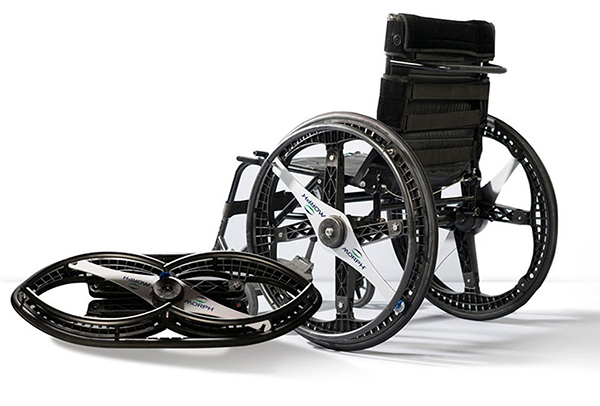
Copyright © Maddak, Inc. Reprinted by SEDL with permission.
Tupperware® Fuel Pack
www.tupperware.com.au/xchg/au/hs.xsl/3383.html
This easy open/easy close food storage system was developed in collaboration with the RERC for Technologies for Successful Aging with Disability (OPTT-RERC)Footnote 25 and Tupperware Brands. Its unique design reduces the amount of strength required for use–which is an advantage for all people with less than average hand strength, including children, as well as older adults who may have arthritis. The product's tight-grip hinged system ensures that lids are not lost. The company picked children as the appropriate initial market entry point, and therefore included an etched half-way capacity measure for portion control that follows recommended serving sizes for kids on the current version of the product. A second version, branded for the older adult population is slated for later release.
Figure 5: Tupperware® Fuel Pack
Figure 5 Text Description [Select image to enlarge]
Hearing Companion App
https://www.createabilityinc.com/
This electronic ear smartphone application for Android was developed in collaboration with SBIR award winner CreateAbility Concepts, Inc. to help people who are deaf or hard-of-hearing to identify sounds in their environment. The app works with multiple data plans, connecting to the internet via cellular Internet or Wi-Fi, and instantaneously communicating with CreateAbility's server (cloud) to identify sounds. The app supports touch screen and keyboard input, and is operable with Bluetooth® microphones that are optimized for sounds in addition to voice. It can also be used with a dashboard mount to detect in-car sounds from police, fire trucks, and ambulances. The Hearing Companion comes with a lifetime upgrade on new versions and the license can be migrated to a new phone, ensuring it will be of value to the user for years to come.
Figure 6. Hearing Companion Smartphone App for Android
Figure 6 Text Description [Select image to enlarge]
Hearing Companion, CreateAbility Concepts, Inc. (CCI), Carmel (Indianapolis), IN.
Copyright © 2011 by CCI. Android is a trademark of Google Inc. Reprinted by SEDL with permission.
Explore a free and accessible knowledge base containing thirty years of information and resources that are helpful for planning, doing and managing your technology transfer and knowledge translation processes.
From the following page, you can explore knowledge base content: http://kt4tt.buffalo.edu/knowledgebase
- The NtK Model: http://kt4tt.buffalo.edu/knowledgebase/model.php
- The game board version of the NtK Model: http://kt4tt.buffalo.edu/knowledgebase/gameboard.php
- Webcasts: http://kt4tt.buffalo.edu/publications/Webcasts/index.php
- Journal articles: http://kt4tt.buffalo.edu/publications/Journals/index.php
- Conference presentations: http://kt4tt.buffalo. edu/publications/ConferencePresentations/
- FOCUS Technical Briefs: http://kt4tt.buffalo.edu/publications/FocusBriefs/index.php
- Resource materials: http://kt4tt.buffalo.edu/publications/ResourceMaterials/index.php
Tap into our publications and presentations to improve innovation policy.
While addressing the needs of practitioners in the AT field, we learned that other government agencies in the U.S. and internationally are experiencing the same problems transferring technology to the marketplace, regardless of the field of application. Governments continue to fund R&D projects at universities while expecting the results to appear in the private sector marketplace. However, there is not yet a sufficient level of direct investment in the linkages between the two. In fact, there is a clear gap between the rhetoric supporting “technological innovation” and the reality of how knowledge is transformed through the related methods of scientific research, engineering development and industrial production. As part of our overall mission we are collaborating with experts in the Science, Technology & Innovation Policy domain to engage government and associated agencies in discussions about how best to link the three methods and the sectors of economic and societal benefit they represent. The following set of Science, Technology, and Innovation Policy-Oriented publications relate to this topic, and offer a platform for anyone interested in improving the outcomes resulting from technology based innovation:
- Pushes and Pulls: Hi(S)tory of the Demand Pull Model of Innovation: http://sth.sagepub.com/content/early/2013/02/12/0162243912473163.abstract
- Methodology Trumps Mythology: https://www.researchgate.net/publication/258481936_Methodology_Trumps_Mythology
- Is America's Science, Technology, and Innovation Policy Open for Business?: http://scienceprogress.org/2012/06/is-america%E2%80%99s-science-technology-and-innovation-policy-open-for-business/
- Déjà Vu Policy: Importing U.S. Innovation Policies from Abroad: http://www.sciencepolicyjournal.org/uploads/5/4/3/4/5434385/deja_vu_policy_20120531.pdf
- A century of talks on research: what happened to development and production?: http://www.inderscience.com/info/inarticle.php?artid=46953
- Research or Development? A Short History of Research and Development as Categories: http://kt4tt.buffalo.edu/publications/Gegenworte.doc
What's Next?
In September 2013, the University at Buffalo was awarded funding to continue the Center on KT4TT's work for another five years. The new award begins October 1, 2013, and Center staff will engage in follow-on activities that will complement and enhance the prior outputs and knowledge that were described in this technical brief. A forthcoming email newsletter will detail the new Center's mission, projects, and personnel. To add your name to our mailing list, send email to: smarnold@buffalo.edu with “Add me to your mailing list” in the subject line or body of the message. Or, stay updated on your own by checking the news page on our website at https://sphhp.buffalo.edu/cat/kt4tt/dissemination/publications-and-presentations/press-releases.html. In closing, we give warm thanks to all who worked with us to produce these outputs over the past five years, and encourage all professionals who serve the disability community to continue innovating!
Footnotes
- Footnote 1
-
https://implementationscience.biomedcentral.com/articles/10.1186/1748-5908-8-21
- Footnote 2
-
https://ktdrr.org/ktlibrary/articles_pubs/ncddrwork/focus/focus28/Focus28.pdf
- Footnote 3
-
http://iospress.metapress.com/content/f384n4gp042732gx/fulltext.html
- Footnote 4
-
https://implementationscience.biomedcentral.com/articles/10.1186/1748-5908-5-9
- Footnote 5
- Footnote 6
-
https://implementationscience.biomedcentral.com/articles/10.1186/1748-5908-7-44
- Footnote 7
-
http://kt4tt.buffalo.edu/publications/Technology%20Transfer%20Plan%20Template.docx
- Footnote 8
- Footnote 9
-
https://ktdrr.org/ktlibrary/articles_pubs/ncddrwork/focus/focus32/Focus32.pdf
- Footnote 10
-
http://kt4tt.buffalo.edu/publications/ResourceMaterials/index.php
- Footnote 11
- Footnote 12
-
http://www.ncddr.org/webcasts/webcast32.html (expired link 12/2017)
- Footnote 13
- Footnote 14
-
http://kt4tt.buffalo.edu/publications/ConferencePresentations/Summary-poster-AEA-2012.docx
- Footnote 15
-
http://www.ingentaconnect.com/content/iri/rtm/2013/00000056/00000004/art00008 (expired link 12/2017)
- Footnote 16
- Footnote 17
- Footnote 18
- Footnote 19
-
http://www.firstwavetechnologies.com/index.htm (expired link 12/2017)
- Footnote 20
-
http://rearlab.gatech.edu/mobilityrerc.php (expired link 12/2017)
- Footnote 21
- Footnote 22
- Footnote 23
-
https://medtrade.com/news/manufacturer-provider/Medtrade-Spring-Awar-679.shtml (url no longer active)
- Footnote 24
- Footnote 25
-
http://www.isi.edu/research/rerc (expired link 12/2017)
CENTER ON KT4TT
The 5-year Center on Knowledge Translation for Technology Transfer (KT4TT) project (http://kt4tt.buffalo.edu) was awarded to the University at Buffalo (SUNY), Center for Assistive Technology (CAT) on October 1, 2008. SEDL and Western New York Independent Living, Inc. (WNYIL), are partners in the project. SEDL's role focuses on utilization-oriented methods of dissemination, training, and technical assistance to effectively communicate with knowledge producers and knowledge users. The WNYIL ensures that consumer input and accessibility considerations are integrated into all Center activities and outputs. This FOCUS Technical Brief is a product of the SEDL-WNYIL-KT4TT partnership.
The project focuses on three key outcomes:
- Improved understanding of the barriers preventing successful knowledge translation for technology transfer and ways to overcome these barriers
- Advanced knowledge of best models, methods, and measures of knowledge translation and technology transfer for achieving outcomes
- Increased utilization of these validated best practices by NIDILRR's technology-oriented grantees
Recommended Citation
Flagg, J. L. (2013). The Center on Knowledge Translation for Technology Transfer: Success stories and resources for R&D practitioners. FOCUS Technical Brief (38). Austin, TX: SEDL, Disability Research to Practice Program.
Address Correspondence
Jennifer L. Flagg
Co-Principal Investigator
Center on Knowledge Translation for Technology Transfer
100 Sylvan Parkway, Suite 400
Amherst, NY 14228
716-204-8606
Fax: 716-204-8610
E-mail: jlflagg@buffalo.edu
Author
Jennifer L. Flagg is presently a Co-Principal Investigator at the NIDILRR-funded Center on Knowledge Translation for Technology Transfer at the University at Buffalo. She holds an MBA and has over a decade of experience in new product development, technology transfer, and the commercialization of rehabilitation and assistive technology devices. Ms. Flagg led the creation of the Need to Knowledge Model for commercializing rehabilitation and AT products and services, and has presented her work internationally throughout the U.S., Canada, Europe, and China. She also works to improve best practices in product development locally through her role as Vice-Chair of the Buffalo Niagara chapter of the Product Development and Management Association.
Acknowledgments
The author gratefully acknowledges colleagues who contributed to the concepts expressed herein. This document is a product of the Center on Knowledge Translation for Technology Transfer (KT4TT) and is published by SEDL. KT4TT is funded under Grant H133A080050 by the National Institute on Disability, Independent Living, and Rehabilitation Research (NIDILRR) of the U.S. Department of Education. The opinions contained in this publication are those of the authors, and you should not assume endorsement by the federal government.
Copyright © 2021 by SEDL
FOCUS: A Technical Brief is published by SEDL's Disability Research to Practice Program for the Center on Knowledge Translation for Technology Transfer (KT4TT). The contents of this document do not necessarily represent the policy of the U.S. Department of Education, and you should not assume endorsement by the federal government.
DISABILITY RESEARCH TO PRACTICE
Advancing Research, Improving Education

SEDL is an equal employment opportunity/affirmative action employer and is committed to affording equal access to education and employment opportunities for all individuals. SEDL does not discriminate on the basis of age, sex, race, color, creed, religion, national origin, sexual orientation, marital or veteran status, or the presence of a disability.
Available in alternate formats upon request. Available online: https://ktdrr.org/ktlibrary/articles_pubs/focus38
- Last Updated:

